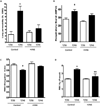Parasympathetic stimulation via the vagus nerve prevents systemic organ dysfunction by abrogating gut injury and lymph toxicity in trauma and hemorrhagic shock
- PMID: 23247120
- PMCID: PMC3547655
- DOI: 10.1097/SHK.0b013e31827b450d
Parasympathetic stimulation via the vagus nerve prevents systemic organ dysfunction by abrogating gut injury and lymph toxicity in trauma and hemorrhagic shock
Abstract
We tested if vagus nerve stimulation (VNS) would prevent gut injury, mesenteric lymph toxicity, and systemic multiple organ dysfunction syndrome following trauma-hemorrhagic shock (T/HS). Four groups of experiments were performed. The first tested whether VNS (5 V for 10 min) would protect against T/HS-induced increases in gut and lung permeability as well as neutrophil priming. In the second experiment, mesenteric lymph was collected from rats subjected to T/HS or trauma-sham shock with or without VNS and then injected into naive mice to assess its biologic activity. Lung permeability, neutrophil priming, and red blood cell deformability were measured. Next, the role of the spleen in VNS-mediated protection was tested by measuring gut and lung injury in splenectomized rats subjected to sham or actual VNS. Lastly, the ability of nicotine to replicate the gut-protective effect of VNS was tested. Vagus nerve stimulation protected against T/HS-induced gut injury, lung injury, and neutrophil priming (P < 0.05). Not only did VNS limit organ injury after T/HS, but in contrast to the mesenteric lymph collected from the sham-VNS T/HS rats, the mesenteric lymph from the VNS T/HS rats did not cause lung injury, neutrophil priming, or loss of red blood cell deformability (P < 0.05) when injected into naive mice. Removal of the spleen did not prevent the protective effects of VNS on gut or lung injury after T/HS. Similar to VNS, the administration of nicotine also protected the gut from injury after T/HS. Vagus nerve stimulation prevents T/HS-induced gut injury, lung injury, neutrophil priming, and the production of biologically active mesenteric lymph. This protective effect of VNS was not dependent on the spleen but appeared to involve a cholinergic nicotinic receptor, because its beneficial effects could be replicated with nicotine.
Conflict of interest statement
No conflicts of interest to report
Figures



Comment in
-
Parasympathetic stimulation via the vagus nerve prevents systemic organ dysfunction by abrogating gut injury and lymph toxicity in trauma and hemorrhagic shock.Shock. 2013 May;39(5):460-1. doi: 10.1097/SHK.0b013e31828def5a. Shock. 2013. PMID: 23591560 No abstract available.
References
-
- Deitch E, Morrison J, Berg R, Specian R. Effect of hemorrhagic shock on bacterial translocation, intestinal morphology, and intestinal permeability in conventional and antibiotic-decontaminated rats. Crit Care Med. 1990;18(5):529–536. - PubMed
-
- Deitch E, Xu D, Franko L, et al. Evidence favoring the role of the gut as a cytokine-generating organ in rats subjected to hemorrhagic shock. Shock. 1994;1(2):141–145. - PubMed
-
- Upperman J, Deitch E, Guo W, et al. Post-hemorrhagic shock mesenteric lymph is cytotoxic to endothelial cells and activates neutrophils. Shock. 1998;10(6):407–414. - PubMed
Publication types
MeSH terms
Substances
Grants and funding
LinkOut - more resources
Full Text Sources
Other Literature Sources

